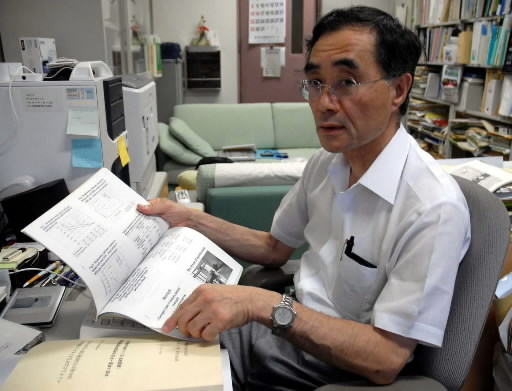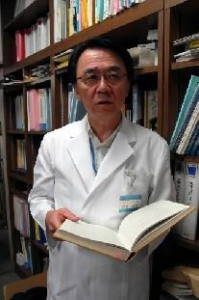Vietnam: 50 years after the use of defoliants, Part 3: Path to a solution, Article 3
Jul. 25, 2012
Article 3: Medical support
Health studies: Share accumulated results
by Takamasa Kyoren, Staff Writer
Poison gas, pollution-related illnesses: Draw on experience
In August a group of researchers will depart for Vietnam to study the effects of defoliants on the health of local residents in cooperation with Hanoi Medical University and other institutions. It will be the 12th trip to Vietnam since 2002 by the group, which includes Teruhiko Kido, 59, a professor who conducts research on medication and health at Kanazawa University’s School of Health Sciences.
In their study the researchers have been comparing data on areas in central Vietnam where defoliants were sprayed and where they were not. As a result, the level of dioxin in local residents’ blood and breast milk and the effects on neural and other functions are becoming clear.
“The effects of defoliants are the result of the Vietnam War, which caused more environmental destruction than any other,” said Professor Kido. The research team’s enthusiasm for the project is based on its experience with itai-itai disease, one of Japan’s so-called “four major pollution-related diseases.” “The issues closely resemble each other in terms of the fear of unseen chemicals as well,” Professor Kido added.
In 1955 a problem with brittleness of the bones of residents along the watershed of the Jinzu River in Toyama Prefecture came to light. The cause was found to be pollution by the heavy metal cadmium, which had been discharged into the river by local mines. For more than 20 years Professor Kido’s group has looked into the level of cadmium, local residents’ illnesses and damage to crops along each of the river’s tributaries. The results of their research have been put to use in developing medical treatments and health care for the victims.
50 years’ worth of data
In recent years Vietnamese students have been coming to Japan to do research on dioxin. “It may be the result of the trust we have built between ourselves and residents and researchers in Vietnam,” Professor Kido said.
During World War II Hiroshima was the site of a factory where the Imperial Japanese Army manufactured poison gas, and doctors in Hiroshima Prefecture have compiled more than 50 years of research on the effects of chemical weapons and relief measures for the victims. From 1929 through the end of the war, an estimated 6,600 factory workers and mobilized students worked at a poison gas plant on Ohkunoshima Island in the city of Takehara. The issue of the effects on their health was essentially swept under the carpet at the end of the war.
“As with defoliants, the effects on people who were exposed to poison gas during its manufacture or disposal were unknown at first,” said Nobuoki Kono, 59, a professor at the graduate school of Hiroshima University. Professor Kono heads a group of doctors from his university and others that studies the effects of the poison gas manufactured on Ohkunoshima.
The effort to determine the effects of the poison gas was launched seven years after the end of the war when doctors at the prefectural medical university, predecessor to the current medical faculty, conducted a health survey of 210 people who had worked on the island. Just after that, a former factory worker in his 30s died suddenly of lung cancer. The doctors, who suspected a link to poison gas, created a list of former workers at the factory and began giving them regular physical examinations. The accumulation of more medical knowledge led to health care and relief measures for the sufferers.
“I had a strong desire to help the patients, so at first I worked without pay,” said Professor Kono. In fiscal year 1974 the central government began to cover the costs. Through fiscal 2011 approximately 90,000 people had been examined and about 3,300 doctors had been involved in the project. Over the years the doctors have developed knowledge on how to examine and treat the patients. Currently, approximately 2,600 patients throughout Japan have been certified by the government as suffering from the effects of poison gas.
Inadequate public relief
About 3 million people in Vietnam suffer from the effects of defoliants. Of these, approximately 200,000 have been certified by the government as sufferers and are receiving aid. But health surveys, which serve as the basis for public relief measures, are not conducted throughout the country, and in many areas the health care system is inadequate.
“The effects of poison gas and dioxin differ from a scientific standpoint, but I think Vietnam can learn from our experience in developing clinical medicine to support the patients and from the relief system we pushed the government to create,” said Professor Kono. Kanazawa University’s Professor Kido, who conducts studies in cooperation with researchers in Vietnam, also said he hoped their efforts would be useful to the people of Vietnam.
Japan has conducted an unparalleled amount of research on poison gas and has implemented many anti-pollution measures. This experience should be able to be shared with Vietnam, which is still suffering.
(Originally published on July 20, 2012)









